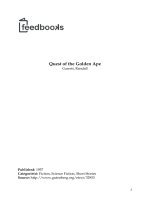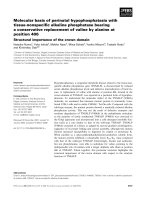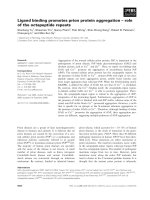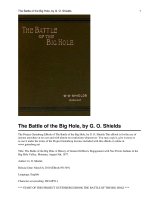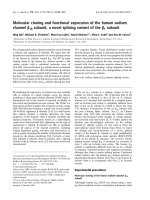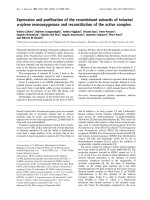Creatures of the Waters Encounter potx
Bạn đang xem bản rút gọn của tài liệu. Xem và tải ngay bản đầy đủ của tài liệu tại đây (3.17 MB, 66 trang )
Creatures of the Waters
Encounter fascinating
animals that live in and around water
CHICAGO LONDON NEW DELHI PARIS SEOUL SYDNEY TAIPEI TOKYO
LEARNING
LIBRARY
B
r
i
t
a
n
n
i
c
a
®
© 2008 BY ENCYCLOPÆDIA BRITANNICA,INC.
Cover photos (front): Robert Yin/Corbis; (back): Royalty-Free/Corbis. Cover insert photos (left): Royalty-Free/Corbis; (center): Royalty-Free/Corbis
International Standard Book Number:978-1-59339-516-2
No part of this work may be reproduced or utilized in any form or by any means, electronic or mechanical, including photocopying, recording, or by any
information storage and retrieval system, without permission in writing from the publisher.
BRITANNICA LEARNING LIBRARY:CREATURES OF THE WATERS 2008
Britannica.com may be accessed on the Internet at .
(Trademark Reg. U.S. Pat. Off.) Printed in U.S.A.
PROJECT TEAM
Judith West, Editorial Project Manager
Christopher Eaton, Editor and Educational
Consultant
Kathryn Harper, U.K. Editorial Consultant
Marilyn L. Barton, Senior Production
Coordinator
Editors
Theodore Pappas
Anthony L. Green
Mary Rose McCudden
Andrea R. Field
Michael J. Anderson
Colin Murphy
Locke Petersheim
Indu Ramchandani (Encyclopædia
Britannica India)
Bhavana Nair (India)
Rashi Jain (India)
Design and Media Specialists
Nancy Donohue Canfield, Design
Megan Newton-Abrams, Design
Karen Koblik, Photos
Joseph Taylor, Illustrations
Amy Ning, Illustrations
Jerry A. Kraus, Illustrations
Michael Nutter, Maps
Copy Editors
Barbara Whitney
Laura R. Gabler
Dennis Skord
Lisa Braucher, Data Editor
Paul Cranmer, Indexer
ENCYCLOPÆDIA BRITANNICA
PROJECT SUPPORT TEAM
EDITORIAL
Linda Berris
Robert Curley
Brian Duignan
Kathleen Kuiper
Kenneth Pletcher
Jeffrey Wallenfeldt
Anita Wolff
Charles Cegielski
Mark Domke
Michael Frassetto
James Hennelly
Sherman Hollar
Michael R. Hynes
Sandra Langeneckert
Gene O. Larson
Michael I. Levy
Robert Lewis
Tom Michael
Janet Moredock
DESIGN
Steven N. Kapusta
Carol A. Gaines
Cate Nichols
ART
Kathy Nakamura
Kristine A. Strom
Nadia C. Venegas
ILLUSTRATION
David Alexovich
Christine McCabe
Thomas Spanos
MEDIA ASSET MANAGEMENT
Jeannine Deubel
Kimberly L. Cleary
Kurt Heintz
Quanah Humphreys
COPY
Sylvia Wallace
Jennifer F. Gierat
Glenn Jenne
Mary Kasprzak
Thad King
Larry Kowalski
Joan Lackowski
Dawn McHugh
Julian Ronning
Chrystal Schmit
Sarah Waterman
INFORMATION MANAGEMENT/
INDEXING
Carmen-Maria Hetrea
Edward Paul Moragne
Marco Sampaolo
Sheila Vasich
Mansur G. Abdullah
Keith DeWeese
Catherine Keich
Stephen Seddon
EDITORIAL TECHNOLOGIES
Steven Bosco
Gavin Chiu
Bruce Walters
Mark Wiechec
COMPOSITION TECHNOLOGY
Mel Stagner
MANUFACTURING
Dennis Flaherty
Kim Gerber
INTERNATIONAL BUSINESS
Leah Mansoor
Isabella Saccà
ENCYCLOPÆDIA BRITANNICA, INC.
Jacob E. Safra,
Chairman of the Board
Jorge Aguilar-Cauz,
President
Michael Ross,
Senior Vice President, Corporate Development
Dale H. Hoiberg,
Senior Vice President and Editor
Marsha Mackenzie,
Managing Editor and Director of Production
In
Creatures of
the Waters
,
you’ll discover answers to
these questions and many
more. Through pictures,
articles, and fun facts,
you’ll learn about the great
diversity of animal life
found in waters around the
world.
INTRODUCTION
How did the “dabbling duck” get its name? What fish can leap up waterfalls?
Is a sponge a plant or an animal? What animals can live both in water and on land?
Creatures of the Waters
To help you on your journey, we’ve provided the following guideposts in
Creatures of the Waters
:
■ Subject Tabs—The colored box in the upper corner of each right-hand
page will quickly tell you the article subject.
■ Search Lights—Try these mini-quizzes before and after you read the
article and see how much—and how quickly—you can learn. You can even
make this a game with a reading partner. (Answers are upside down at the
bottom of one of the pages.)
■ Did You Know?—Check out these fun facts about the article subject.
With these surprising
“
factoids,” you can entertain your friends, impress
your teachers, and amaze your parents.
■ Picture Captions—Read the captions that go with the photos. They
provide useful information about the article subject.
■ Vocabulary—New or difficult words are in bold type. You’ll find
them explained in the Glossary at the end of the book.
■ Learn More!—Follow these pointers to related articles in the book. These
articles are listed in the Table of Contents and appear on the Subject Tabs.
LEARNING
LIBRARY
B
r
i
t
a
n
n
i
c
a
®
Have a great trip!
© 2008 Encyclopædia Britannica, Inc.
© 2008 Encyclopædia Britannica, Inc.
Creatures of the Waters
TABLE OF CONTENTS
INTRODUCTION . . . . . . . . . . . . . . . . . . . . . . . . . . . . . 3
WATERBIRDS
Albatrosses: Forever Gliding . . . . . . . . . . . . . . . . . . . 6
Ducks: Dabblers, Divers, and Perchers. . . . . . . . . . . . 8
Geese: Fine-Feathered Travelers . . . . . . . . . . . . . . . 10
Gulls: The Ocean’s Cleanup Crew . . . . . . . . . . . . . . . 12
Penguins: Well-Dressed Swimmers . . . . . . . . . . . . . 14
Swans: Birds of Beauty, Grace, and Speed . . . . . . . . 16
WATER-WISE AMPHIBIANS AND REPTILES
Amphibians: The Land-and-Water Dwellers . . . . . . . 18
Frogs: Amazing Changing Amphibians . . . . . . . . . . 20
Alligators and Crocodiles: Modern Dinosaurs . . . . . . 22
Anacondas: A Tight Squeeze . . . . . . . . . . . . . . . . . . 24
Turtles: Taking Their Time . . . . . . . . . . . . . . . . . . . 26
FRESH FISH!
Fish: Citizens of the Waters . . . . . . . . . . . . . . . . . . . 28
Carp: The Fishy Survivor . . . . . . . . . . . . . . . . . . . . . 30
Piranhas: Frightening Little Fish. . . . . . . . . . . . . . . 32
Salmon: Leaping Up the Waterfall . . . . . . . . . . . . . . 34
Sharks: Predators of the Sea . . . . . . . . . . . . . . . . . . 36
MOSTLY MARINE MARVELS
Coral: Builders in the Sea . . . . . . . . . . . . . . . . . . . . 38
Deep-Sea Life: Flashing Lights!. . . . . . . . . . . . . . . . 40
Jellyfish: Boneless Blobs of the Sea . . . . . . . . . . . . . 42
Mollusks: Shell-Dwelling Animals . . . . . . . . . . . . . . 44
Octopuses: Eight-Armed Wonders . . . . . . . . . . . . . . 46
Sponges: Plants or Animals?. . . . . . . . . . . . . . . . . . 48
AQUATIC MAMMALS
Buffalo: Water-Loving Beasts. . . . . . . . . . . . . . . . . . 50
Hippopotamuses: Kings of the River . . . . . . . . . . . . 52
Manatees: Mermaids of Yore?. . . . . . . . . . . . . . . . . . 54
Muskrats: The Town Builders . . . . . . . . . . . . . . . . . 56
Walruses: The Whale Horses . . . . . . . . . . . . . . . . . . 58
Whales: The Biggest Animals of All . . . . . . . . . . . . . 60
GLOSSARY . . . . . . . . . . . . . . . . . . . . . . . . . . . . . . . 62
INDEX . . . . . . . . . . . . . . . . . . . . . . . . . . . . . . . . . . . 63
LEARNING
LIBRARY
B
r
i
t
a
n
n
i
c
a
®
© 2008 Encyclopædia Britannica, Inc.
Albatrosses use their long wings to soar and
glide on air currents. They can stay in the air
for hours without flapping their wings. The
black-browed albatross, shown here in flight,
has a dark marking around the eye that
makes it look as though it is frowning.
Which
of the
following can
be said about
an albatross?
a) It spends most
of its time on land.
b) It eats other birds.
c) It goes to land only
to lay eggs.
S
E
A
R
C
H
L
I
G
H
T
© 2008 Encyclopædia Britannica, Inc.
ALBATROSSES
7
The albatross is an amazing seabird. It spends most of its life soaring
above the water. The only time albatrosses ever go ashore is when they lay
eggs and raise their chicks. Groups (called “colonies”) of the birds build
nests on isolated Antarctic islands. A
single large white egg is laid in a
bowl-shaped nest built from plants and
soil. Sometimes the nest is just a patch
of bare ground.
A young albatross grows slowly. It
takes at least four months for it to
develop all the feathers it will need to
fly. Once it’s able to fly, the albatross
will spend the next five to ten years
out at sea. The albatross can glide for
hours at a time, without flapping its
long narrow wings. To stay in the air like this, it needs windy weather. In
calm weather the albatross has trouble keeping its heavy body in the air, so
it rests on the water and floats like a cork. It feeds on small squid and
fish. But it will also follow fishing boats and eat scraps that are
thrown overboard.
Some kinds of albatrosses are brown, but most of them are white
with some brown or black markings on their bodies or wings.
Albatrosses are the largest of all flying birds. In fact, the wandering
albatross has the largest wingspread among living birds. The wings of
a wandering albatross can measure 11 feet from tip to tip.
Albatrosses live very long lives and are one of the few species of
birds that die of old age.
L
EARN MORE! READ THESE ARTICLES…
DUCKS • GULLS • PENGUINS
Answer: c) It goes to land only to lay eggs.
★
© Peter Johnson/Corbis
F
o
r
e
v
e
r
G
l
i
d
i
n
g
In the past,
sailors believed
albatrosses had
special powers.
They believed
that killing the
bird would bring
bad luck.
DID YOU
KNOW?
Scientists measuring an albatross’ wingspread.
© Wolfgang Kaehler/Corbis
© 2008 Encyclopædia Britannica, Inc.
8
DID YOU KNOW?
Ducks make their feathers waterproof
by rubbing oil on them. They get the
oil from special glands on their
chests and rub it on their feathers
with their bills.
Unscramble
these words
that have to do
with a duck.
wsmimre
nblbiadg
dlwaed
S
E
A
R
C
H
L
I
G
H
T
A male wood duck is easily identifiable by his
purple and green head, his reddish-brown breast
flecked with white, and his bronze sides.
© Gary W. Carter/Corbis
© 2008 Encyclopædia Britannica, Inc.
DUCKS
9
Ducks are champion swimmers and are at home almost anywhere near
water. Some feed and nest in streams and ponds. Others live near deep
wide lakes. Some make their homes on rocky cliffs by the ocean.
There are three kinds of ducks:
“Dabbling ducks” put their heads underwater to eat plants that grow
there. This way of feeding is called “dabbling.” They build their nests in
hollows near the water. There they also eat
plants and insects found near the shore.
Dabbling ducks can fly very fast.
“Diving ducks” dive deep down into the
water to find things to eat. They mostly eat fish.
They are very strong swimmers.
“Perching ducks” make nests in trees and
hold on to the branches with their long-clawed
toes. This is called perching. Some may perch on
the tall stalks that grow over marshy ponds.
All ducks are graceful fliers and swimmers.
But on the ground they waddle from side to side,
moving slowly in a funny, jerky way. You
usually don’t see a duck waddling too far away
from water.
In winter many ducks fly south, where the
water is warmer and there’s more to eat. But icy
cold water doesn’t bother them. A thick inner layer of soft fluffy feathers
called “down” keeps them warm. And their bigger outer feathers help too.
They’re waterproof. Feathers are a duck’s raincoat. Every year ducks lose
their old feathers, and new feathers grow in. This is called “molting.” Until
the new feathers grow, ducks can’t fly. So they hide in the grass or on the
water to keep safe from enemies.
L
EARN MORE! READ THESE ARTICLES…
GEESE • GULLS • SWANS
Answer: wsmimre = swimmer
nblbiadg = dabbling
dlwaed = waddle
★
(Top) A dabbling gadwall duck;
(bottom) young girl holding a fluffy
duckling.
© Roger Wilmshurst—Frank Lane
Picture Agency/Corbis
© Royalty-Free/Corbis
D
a
b
b
l
e
r
s
,
D
i
v
e
r
s
,
a
n
d
P
e
r
c
h
e
r
s
© 2008 Encyclopædia Britannica, Inc.
10
Geese are found virtually everywhere. There’s the wild Canada goose,
and halfway around the world is the snow goose of Siberia. There is the
pied goose, which lives “down under” in Australia. The rarely seen
Hawaiian goose lives out in the middle of the Pacific Ocean. The little
brant goose nests in very cold Arctic areas. The wild goose called the
greylag is found in Europe.
Geese spend a lot of time in the water. Like ducks, they have a coat of
oil on their feathers that keeps them from getting too wet. And the soft
feathers beneath, called “down,” keep them
warm even in the iciest of waters. Down is
so good at keeping things warm that people
often use it in winter coats and in
comforters. It’s also good in pillows
because it’s so soft.
Geese are fairly large birds, often
standing three feet tall despite their short
legs. Geese may look somewhat silly when
they waddle on land. But their sturdy legs
actually help them walk more steadily than
ducks or swans do.
Geese have webbed feet that make them
strong swimmers. They are also powerful
fliers. They can make especially long
flights during their annual migrations to
their winter feeding grounds. You may see
groups of geese traveling south in the fall in
lines that make a V shape. This formation helps keep them from getting
tired as they fly because each goose gets a lift from the air flowing off the
goose ahead.
L
EARN MORE! READ THESE ARTICLES…
DUCKS • GULLS • SWANS
(Top) Mother goose nuzzling her gosling (young
goose); (bottom) snow geese flying in a V
formation.
© Julie Habel/Corbis © D. Robert & Lorri Franz/Corbis
DID YOU KNOW?
People in Asia and Europe have kept
geese as guards. Geese make loud
honking cries when danger appears.
After chasing the enemy away, they
cackle triumphantly.
F
i
n
e
-
F
e
a
t
h
e
r
e
d
T
r
a
v
e
l
e
r
s
© 2008 Encyclopædia Britannica, Inc.
GEESE
11
Answer: People use down to stuff pillows, quilts, and coats
because the feathers are soft and very warm.
★
How
do people
use
down feathers?
S
E
A
R
C
H
L
I
G
H
T
A Canada goose flies close to the water.
© Getty Images
© 2008 Encyclopædia Britannica, Inc.
12
Gulls are among the most common waterbirds of ocean
and coastal zones worldwide. Some gulls travel enormous
distances between their summer and winter homes.
How
are gulls
helpful to
humans?
S
E
A
R
C
H
L
I
G
H
T
© 2008 Encyclopædia Britannica, Inc.
GULLS
13
Afishing boat chugs back into the harbor with its day’s catch. The gulls
follow close behind. They know that the fishermen will be throwing
goodies overboard as they empty the bait bag and clean the deck. The gulls
dip into the waves to scoop up bits of food. They fill the air with their
excited cries. This often happens when they are
fighting over something good to eat.
Along the shore, gulls are helpful to the
people who clean beaches and harbors. They
swoop down to pick up messy things. Gulls eat
almost anything, from dead fish to potato chips
and scraps of hot dogs. And they clear away lots
of insects too.
Gulls eat all day long. They have to just to
stay alive. Gulls are big birds that fly great
distances. While flying, they use up a lot of
energy. Gulls can fly many miles without
stopping. They can fly from one end of a
country to the other. But all the time they’re up
there, they’re looking down to see if they can find something to eat.
Gulls are good swimmers too. Their feet are webbed.
The little stretches of skin between their toes
make their feet act as paddles.
Gulls are also floaters. They stay on top of the
water like a piece of wood does. On long trips over
the ocean, they drop down onto the water and float
while taking a nap.
L
EARN MORE! READ THESE ARTICLES…
ALBATROSSES • DUCKS • FISH
Answer: Gulls clean up a lot of food waste from beaches, harbors,
picnic areas, dumps, and parking lots that would otherwise be left
behind as trash.
★
© Chris Jones/Corbis
Seagull stands on a rock.
© Guy Motil/Corbis
DID YOU KNOW?
The type of gull called Bonaparte’s
gull was named after Charles-Lucien
Bonaparte, a nephew of the famous
French emperor Napoleon Bonaparte.
The younger Bonaparte spent much
of his life studying the world’s birds.
T
h
e
O
c
e
a
n
’
s
C
l
e
a
n
u
p
C
r
e
w
© 2008 Encyclopædia Britannica, Inc.
Penguins are excellent divers and swimmers. Here,
gentoo penguins enjoy a romp through the water.
Do
penguins have
feathers?
S
E
A
R
C
H
L
I
G
H
T
© 2008 Encyclopædia Britannica, Inc.
PENGUINS
15
When a penguin swims, its light-colored belly and dark-colored back
help hide it from enemies. From underneath, its light belly looks like the
sky. This makes it hard for its enemy the leopard seal to see it. From
above, its dark back looks like the dark water,
which helps hide it from big hunting birds.
Penguins cannot fly, but they swim
extremely well. The shape of their bodies, sort
of like a submarine, lets them swim very fast.
They use their short flat wings like flippers and
practically fly through the water. In fact, they
often leap out of the water and look as if they
are trying to flap through the air.
There are 17 types of penguins. They live in
Antarctica and along the cool portions of the
coasts of Africa, New Zealand, Australia, and
South America. Penguins have a thick layer of
fat that helps to protect them from the cold. And
although they don’t look like they do, they actually have feathers all over
their bodies. These short feathers also help to keep them warm.
Penguins’ short legs give them an odd walk. They do, however, run
quickly. Sometimes they’ll build up speed and then slide on their bellies to
travel quickly over ice and snow.
Penguins live in nesting colonies. These colonies can be
enormous. Penguins return to the same place, the same nest, and the
same partner every year—sometimes traveling long distances.
Penguins use the Sun to help them find their direction. Most
penguins build a nest on the ground with pebbles, mud, and
vegetation. The females lay one or two eggs, and then both parents
take turns looking after them.
L
EARN MORE! READ THESE ARTICLES…
ALBATROSSES • GULLS • SWANS
Answer: Like all birds, penguins have feathers. But theirs are so
short and close to their bodies that the feathers look more like
skin.
★
© George D. Lepp/Corbis
W
e
l
l
-
D
r
e
s
s
e
d
S
w
i
m
m
e
r
s
Penguins
are the only
birds that
can swim
but not fly.
DID YOU
KNOW?
Members of the emperor penguin
species, the largest of the penguins.
© Tim Davis/Corbis
© 2008 Encyclopædia Britannica, Inc.
Ducks, geese, and swans are the three main kinds of waterfowl. Swans
are the largest of the three, and they are also the fastest flyers and
swimmers. They have a stately and dignified appearance when swimming
on a pond.
Like the other waterfowl, swans have oily feathers that stay dry in the
water. Their webbed feet make them strong swimmers. Swans are heavy-
bodied birds that feed by dabbling—
dipping the long neck into shallow
water for plants. They don’t dive for
food. They have powerful wings for
flying long distances.
The whistling swan and the
trumpeter swan are found in North
America, while the mute swan lives
in Europe and Asia. These birds are
white. South America is the home of
the black-necked swan, while the beautiful black swan lives in Australia. It
is the state emblem of Western Australia.
Swans make a variety of sounds. Even the mute swan often hisses or
makes soft snoring sounds. It may even grunt sharply.
The male swan is called a “cob.” The female is called a “pen.” They
look alike. A pair of swans usually stays together for life. The female swan
lays about six pale eggs on a heap of plant material, while the male keeps
close guard. The young swans are called “cygnets.” They can run and swim
just a few hours after they hatch. But father and mother swan look after
them carefully for several months. Sometimes the cygnets
will ride on their mother’s back when they get tired
from swimming or need protection from enemies.
L
EARN MORE! READ THESE ARTICLES…
DUCKS • GEESE • GULLS
16
Mother swan and cygnets.
© AFP/Corbis
DID YOU KNOW?
E.B. White’s
The Trumpet of the Swan
is a story about a voiceless swan that
learns to play a trumpet.
B
i
r
d
s
o
f
B
e
a
u
t
y
,
G
r
a
c
e
,
a
n
d
S
p
e
e
d
© 2008 Encyclopædia Britannica, Inc.
SWANS
17
Answer: Both ducks and swans are waterbirds with oily feathers
and webbed feet for swimming. But swans are considerably bigger
than ducks. They fly and swim faster than ducks too.
★
A family of mute swans, with cygnets riding on
their mother’s back, swim along the water.
© Philip Perr y—Frank Lane Picture Agency/Corbis
What’s
one way
that ducks and
swans are alike?
How are they
different?
S
E
A
R
C
H
L
I
G
H
T
© 2008 Encyclopædia Britannica, Inc.
18
What’s
so special
about amphibians?
(Hint: Remember
those Greek words.)
S
E
A
R
C
H
L
I
G
H
T
DID YOU KNOW?
Salamanders were once believed to
live in fire. The word “salamander”
comes from ancient words that mean
“fire lizard.”
© 2008 Encyclopædia Britannica, Inc.
AMPHIBIANS
19
Answer: Amphibians are one of the few groups of animals that
can live comfortably both in the water and on the land.
★
Millions of years ago, a group of fish began to breathe
both in and out of the water. Eventually these fish made
their way onto land and began to develop legs. These
animals became amphibians, the ancestors of frogs, toads,
and salamanders.
The word “amphibian” comes from the Greek words amphi,
which means “both,” and bios, which means “life.” As their name
suggests, amphibians live both in freshwater and on land.
Amphibians are cold-blooded animals. This means that an
amphibian’s body temperature generally matches the temperature around
it. To warm up, amphibians often bask in the sun, and to cool off, they
move into the shade. Amphibians must also stay near water. If their skin
dries out, they will die.
There are three main groups of amphibians. The largest group
includes the true frogs, tree frogs, and toads. True frogs have long hind
legs and can swim and leap very well. Tree frogs have suction pads on
their fingers and toes and can hold on to smooth surfaces. Toads have
shorter legs than frogs, and their skin has a warty appearance.
The second group of amphibians is the salamanders, which have tails.
The giant salamander of Japan and China is the largest of all amphibians.
It can grow to a length of more than five feet.
The third group is the caecilians. These odd amphibians are rarely seen.
They have long slender bodies with no arms or legs. They are also blind. A
long flexible structure called a “tentacle” sticks out next to each of their
useless eyes. They use these tentacles to feel and sniff their way around.
L
EARN MORE! READ THESE ARTICLES…
FISH • FROGS • TURTLES
T
h
e
D
w
e
l
l
e
r
s
L
a
n
d
-
a
n
d
-
W
a
t
e
r
© 2008 Encyclopædia Britannica, Inc.
20
© 2008 Encyclopædia Britannica, Inc.
FROGS
21
Frogs are amphibians. This means they can
live both in water and on land. And they have a
life cycle that takes place in both environments.
A mother frog lays her eggs in the water. In a
few days tiny tadpoles, or pollywogs, wriggle out
of the eggs. The tadpoles don’t look like frogs at
all. They have long tails for swimming and slits called gills for breathing.
As a tadpole grows into a frog, it changes in many ways. Its tail gets
shorter and shorter until it disappears. At
the same time, the frog grows front and
hind legs. The hind feet have long toes
with webs between them to help in
swimming and leaping. Plus, the gills
disappear and lungs develop. Once these
changes are complete, the creature is ready
to live on land as well as in the water. It’s
now a frog. For some kinds of frogs, this
process of change takes just two months.
For others, it may take as long as three years.
A frog has smooth moist skin. Its eyes are so big that they seem about
to pop out of its head. These eyes help it find food. Its hind legs are
more than twice as long as its front ones. The frog travels in
great leaps on these long strong legs.
Frogs are closely related to toads. What’s the difference
between a frog and a toad? Well, a toad’s skin is dry and
bumpy. Its legs are short, so it can only hop, not leap. And
toads spend more of their time on land than frogs do.
L
EARN MORE! READ THESE ARTICLES…
AMPHIBIANS • FISH • TURTLES
Answer: daploet = tadpole
sligl = gills
traew = water
★
Red-eyed leaf frog tadpoles.
© Michael & Patricia Fogden/Corbis
The tree frog has long legs and sticky
suckerlike disks on its feet for climbing.
© Darren Maybury—Eye Ubiquitous/Corbis
DID YOU KNOW?
The Goliath frog of West Africa is
nearly 12 inches long!
Unscramble
the following
words that relate
to frogs.
daploet
sligl
traew
S
E
A
R
C
H
L
I
G
H
T
A
m
p
h
i
b
i
a
n
s
A
m
a
z
i
n
g
C
h
a
n
g
i
n
g
© 2008 Encyclopædia Britannica, Inc.
Today, many alligators and crocodiles are in danger of becoming extinct. One reason is
that many are killed each year for sport or for their skins, which are used to make purses,
shoes, and belts. These crocodiles are lying in the grass near Moramanga, Madagascar.
© Wolfgang Kaehler/Corbis
True
or false?
Alligator is
another name
for a crocodile.
S
E
A
R
C
H
L
I
G
H
T
22
© 2008 Encyclopædia Britannica, Inc.
ALLIGATORS AND CROCODILES
23
If you’re looking for reptiles that have been around since the days of the
dinosaurs, try alligators and crocodiles. These large lizardlike animals are
related to the giant reptiles of the past.
Alligators and crocodiles are closely related. They look a lot alike, but
alligators have a broad flat head with a rounded snout. Most crocodiles
have a narrow, pointed snout. When a
crocodile closes its mouth, the fourth tooth on
each side of its lower jaw sticks out.
Crocodiles are larger than alligators. They
range from 7 to more than 20 feet long, while
most alligators are about 6 to 8 feet long.
Alligators and most crocodiles live along
the edges of large bodies of freshwater such
as lakes, swamps, and rivers. They spend a lot
of time in the water, but they can also be
found on land near the water. Large adults can stay underwater for
over an hour without breathing.
Both animals have long snouts, powerful tails, and thick skin
with bony plates underneath. Their eyes, ears, and nostrils are
located on top of their long heads. Alligators and crocodiles often
float with only their eyes and noses showing.
Crocodiles can be found in tropical swamps and rivers in
Asia, Australia, Africa, and South America. Alligators are less
widespread. The American alligator lives in the southeastern
United States. In South America there are various alligators called
caimans. The Chinese alligator lives in the Yangtze River and is
smaller than the American alligator.
Adult alligators and crocodiles eat mostly fish, small
mammals, and birds. Sometimes they may kill deer or cattle.
Crocodiles are more likely than alligators to attack humans, though
alligators will attack if cornered.
Answer: FALSE. Though they are related, alligators and crocodiles
are two different animals.
★
M
o
d
e
r
n
D
i
n
o
s
a
u
r
s
Alligators in the Okefenokee Swamp, Georgia.
© David Muench/Corbis
There are
saltwater
crocodiles living
in northern
Australia and
Southeast Asia.
Australians call
their crocodiles
“salties.”
DID YOU
KNOW?
LEARN MORE! READ THESE ARTICLES…
AMPHIBIANS • MANATEES • TURTLES
© 2008 Encyclopædia Britannica, Inc.
24
Find
and correct
the error in
the following
sentence:
Anacondas kill
their prey with a
poisonous bite
.
S
E
A
R
C
H
L
I
G
H
T
© 2008 Encyclopædia Britannica, Inc.


